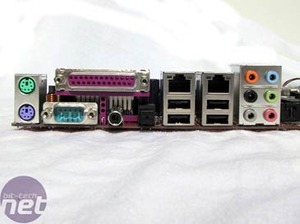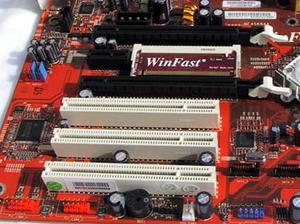There is only one PCI-Express x1 slot on the motherboard but, in saying that, we believe that Foxconn are aware that most of their target audience are going to look to re-use their existing PCI add-in cards rather than opt for new PCI-Express x1 add-in cards that are few and far between at the moment. If they were likely to purchase add-in cards, we believe that they’d be looking towards the more competitively priced PCI-based solutions.
The onboard audio is powered by the 8-channel Realtek ALC850 codec, which is the best AC97 solution available at the moment. It is not really a comparison to the Creative HD audio that MSI chose to implement on their K8N Diamond motherboard that we looked at here. In saying that, there are three PCI expansion slots available should you feel the need to use something a little better than the onboard solution.


Foxconn played it safe when designing the back I/O panel, which provides a pretty standard mix of legacy and new ports. There’s P/S2 mouse and keyboard sockets, single COM and Parallel ports, RCA digital S/PDIF and optical S/PDIF, four USB 2.0 ports and two Gigabit Ethernet LAN sockets and six 3.5mm audio jacks providing support for the 7.1 AC97 surround sound. Notice, no IEEE Firewire support out the box unfortunately but you do get a bit of everything else.
A slight irritation that we have with this motherboard is the non-removable speaker – you can’t even disable it. We’re sure that the PC speaker won’t bother all that many people, but if you’re one of those who prefers their system to start up without a diagnostic speaker going off your only option is to take the soldering iron to it.
SuperBoot basically saves the system core information so the PC doesn’t need to recheck it every time you restart; thus saving time. SuperBIOS-Protect is a useful feature that is a simple write protection mechanism, protecting the motherboard BIOS from viral attack. SuperRecovery is an innovative tool for hard disk backup and recovery. It allows you to hide a section of an IDE hard disk so that you can protect the data, partition table or CMOS settings from read access and even formatting and partitioning from other applications.
Finally, SuperSpeed is Foxconn’s overclocking and tweaking tool. It features frequency adjustment for the front side bus up to 300MHz, as well as HTT multiplier adjustment, and complete memory timing adjustments for CAS, tRAS, tRCD, tRP tRRD and Command Rate. There’s also PCI-Express frequency from 100-145MHz in 1MHz increments, CPU voltage range of CPU default to +140mV (0.14V) and memory voltage adjustable to 2.85V.
The upper limit settings are a little tame in comparison to other boards on the market, but there is still clearly something to play with. Although sounding like it’s straight out of The Incredibles movie, the Super settings do offer a complete package of tweaking and protection, especially the SuperRecovery feature. Having a completely locked out section of disk hidden from everything is easy to use and should be very secure, however it still doesn’t prevent the loss of data if a disk physically fails, or if your motherboard fails and you’re unable to buy a new one for some reason. Any speed saving from the SuperBoot is somewhat negated by the fact you have to wait for the NVIDIA and Silicon Image RAID to search for arrays, which makes that feature slightly pointless in some respects.
In general, the BIOS is well laid out, easy to navigate and easy to get used to. A nice inclusion is the ability to use either PCI x16 slot as the primary display by selecting the option in the BIOS. This allows you to put your graphics card below the only PCI-Express x1 slot, freeing it up and not hindering airflow to the graphics heatsink fan.
The onboard audio is powered by the 8-channel Realtek ALC850 codec, which is the best AC97 solution available at the moment. It is not really a comparison to the Creative HD audio that MSI chose to implement on their K8N Diamond motherboard that we looked at here. In saying that, there are three PCI expansion slots available should you feel the need to use something a little better than the onboard solution.


Foxconn played it safe when designing the back I/O panel, which provides a pretty standard mix of legacy and new ports. There’s P/S2 mouse and keyboard sockets, single COM and Parallel ports, RCA digital S/PDIF and optical S/PDIF, four USB 2.0 ports and two Gigabit Ethernet LAN sockets and six 3.5mm audio jacks providing support for the 7.1 AC97 surround sound. Notice, no IEEE Firewire support out the box unfortunately but you do get a bit of everything else.
A slight irritation that we have with this motherboard is the non-removable speaker – you can’t even disable it. We’re sure that the PC speaker won’t bother all that many people, but if you’re one of those who prefers their system to start up without a diagnostic speaker going off your only option is to take the soldering iron to it.
The BIOS:
Foxconn have implemented four of their own unique features in to a BIOS based on the Phoenix AwardBIOS. The features include SuperBoot, SuperBIOS-Protect, SuperRecovery and SuperSpeed.SuperBoot basically saves the system core information so the PC doesn’t need to recheck it every time you restart; thus saving time. SuperBIOS-Protect is a useful feature that is a simple write protection mechanism, protecting the motherboard BIOS from viral attack. SuperRecovery is an innovative tool for hard disk backup and recovery. It allows you to hide a section of an IDE hard disk so that you can protect the data, partition table or CMOS settings from read access and even formatting and partitioning from other applications.
Finally, SuperSpeed is Foxconn’s overclocking and tweaking tool. It features frequency adjustment for the front side bus up to 300MHz, as well as HTT multiplier adjustment, and complete memory timing adjustments for CAS, tRAS, tRCD, tRP tRRD and Command Rate. There’s also PCI-Express frequency from 100-145MHz in 1MHz increments, CPU voltage range of CPU default to +140mV (0.14V) and memory voltage adjustable to 2.85V.
The upper limit settings are a little tame in comparison to other boards on the market, but there is still clearly something to play with. Although sounding like it’s straight out of The Incredibles movie, the Super settings do offer a complete package of tweaking and protection, especially the SuperRecovery feature. Having a completely locked out section of disk hidden from everything is easy to use and should be very secure, however it still doesn’t prevent the loss of data if a disk physically fails, or if your motherboard fails and you’re unable to buy a new one for some reason. Any speed saving from the SuperBoot is somewhat negated by the fact you have to wait for the NVIDIA and Silicon Image RAID to search for arrays, which makes that feature slightly pointless in some respects.
In general, the BIOS is well laid out, easy to navigate and easy to get used to. A nice inclusion is the ability to use either PCI x16 slot as the primary display by selecting the option in the BIOS. This allows you to put your graphics card below the only PCI-Express x1 slot, freeing it up and not hindering airflow to the graphics heatsink fan.

MSI MPG Velox 100R Chassis Review
October 14 2021 | 15:04






Want to comment? Please log in.